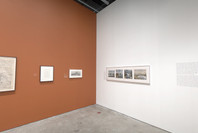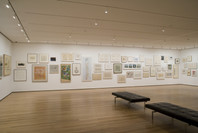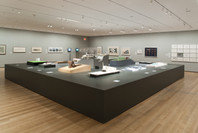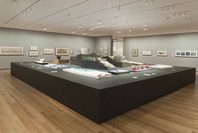These purely theoretical drawings from The Continuous Monument series illustrate Superstudio's conviction that by extending a single piece of architecture over the entire world they could "put cosmic order on earth." The white, gridded, monolithic structures span the natural landscape and assert rational order upon it. Superstudio saw this singular unifying act, unlike many modern utopian schemes, as nurturing rather than obliterating the natural world.
Gallery label from From the Collection: 1960-69, March 26, 2016 - March 12, 2017.
Superstudio was founded by five architects in Florence in 1966, and became the most poetic and incisive group to come out of Italy in the ensuing decade. Their purely theoretical drawings from The Continuous Monument series illustrate their conviction that by extending a single piece of architecture over the entire world they could "put cosmic order on earth." In the urban context, The New York Extrusion extends the city's profile over a section of Manhattan, and grafts nature to it by reflecting the blue sky in tops of the buildings. In the other drawings, there are white, gridded, monolithic structures that span the natural landscape to assert rational order upon it. Superstudio saw this singular unifying act, unlike many modern utopian schemes, as nurturing rather than obliterating the natural world.
Publication excerpt from an essay by Bevin Cline and Tina di Carlo, in Terence Riley, ed., The Changing of the Avant-Garde: Visionary Architectural Drawings from the Howard Gilman Collection, New York: The Museum of Modern Art, 2002, p. 72.





